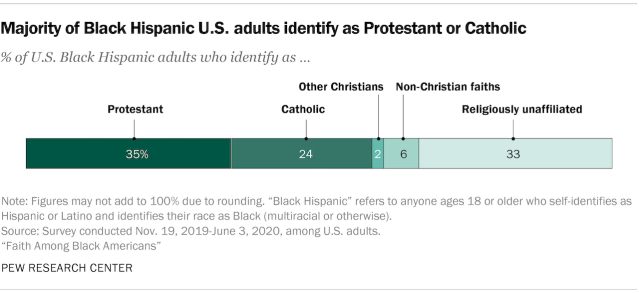The Black population of the United States is growing. In 2022, there were an estimated 47.9 million people who self-identified as Black, making up 14.4% of the country’s population. This marks a 32% increase since 2000, when there were 36.2 million Black people living in the U.S.
Black Americans are diverse. This group consists of people with varied racial and ethnic identities and experiences. The nation’s Black population includes those who say their race is Black, either alone or in combination with other racial backgrounds. It also includes Hispanics or Latinos who say their race is Black.
This fact sheet is a profile of the demographic, geographic and economic characteristics of the U.S. Black population in 2022, presented through the lens of four different groups:
- The total U.S. Black population
- Single-race, non-Hispanic Black people
- Multiracial, non-Hispanic Black people
- Black Hispanic people
Scroll down or click through the navigation bar on the left to learn more.
Click here for a downloadable spreadsheet of these findings.
Related: Key facts about the nation’s 47.9 million Black Americans
The analysis presented in this fact sheet is based on Pew Research Center tabulations of microdata from the Census Bureau’s 2022 American Community Survey (ACS), provided through the Integrated Public Use Microdata Series (IPUMS) from the University of Minnesota.
All displayed numbers are rounded. Shares and percent changes are calculated using unrounded numbers. The detailed tables which have been made available display unrounded tabulations using IPUMS data.
This fact sheet relies on respondent self-identification of race and ethnicity in the Census Bureau’s 2022 ACS to identify the nation’s Black population. The racial and ethnic categories used in census data have changed over time – including question wording, formatting and instructions – and may affect how people identify by race and ethnicity. Read “What Census Calls Us” for more details on how U.S. racial and ethnic categories have changed since 1790. Moreover, respondents’ perceptions of the questions and their own racial and ethnic identity can change in response to individual circumstances and the way the nation sees race and itself.
Unless otherwise noted, adults are those who are ages 18 and older.
U.S. Black population or total Black population refers to the population of Americans who self-identify as Black in the United States. This includes those who say their race is only Black and that they are not Hispanic; those who say Black is one of two or more races in their identity and they are not Hispanic; and those who say their race is Black alone or who say that one of their races is Black but also indicate they are of Hispanic or Latino origin. The terms Black population and Black people are used interchangeably in this fact sheet.
The terms single-race, non-Hispanic Black; single-race Black; and Black alone, non-Hispanic are used interchangeably throughout this fact sheet to refer to the same population. This population is made up of individuals who self-identify only as Black and do not identify as Hispanic or Latino.
The terms multiracial, non-Hispanic Black and multiracial Black are used interchangeably throughout this fact sheet to refer to people who self-identify with two or more races and do not identify as Hispanic or Latino.
The term Black Hispanic is used to refer to those who self-identify as Hispanic or Latino and as Black, either alone or in combination with other races. This group is not the same as the nation’s Afro-Latino population as not all Black Hispanics identify as Afro-Latino and not all Afro-Latinos identify as Black or Hispanic.
Foreign born refers to persons born outside of the United States to parents neither of whom was a U.S. citizen. The terms foreign born and immigrant are used interchangeably.
U.S. born refers to persons born in the 50 states, the District of Columbia, Guam, Puerto Rico, or the U.S. Virgin Islands. The term also refers to those born abroad to a parent who was a U.S. citizen.
In this publication, the general fertility rate refers to the share of females who gave birth in the previous 12 months. This measure of fertility does not account for the birth of more than one child by a single female in a 12-month period.
Population growth
An estimated 47.9 million people in the U.S. identified as Black in 2022. The Black population has grown by more than 10 million since 2000, when 36.2 million of the U.S. population identified as Black, marking a 32% increase over roughly two decades.
In 2022, there were 5.1 million foreign-born Black Americans, about 11% of the U.S. Black population. This is an increase from 2000, when 2.4 million people, or 7%, among the Black population were foreign born.
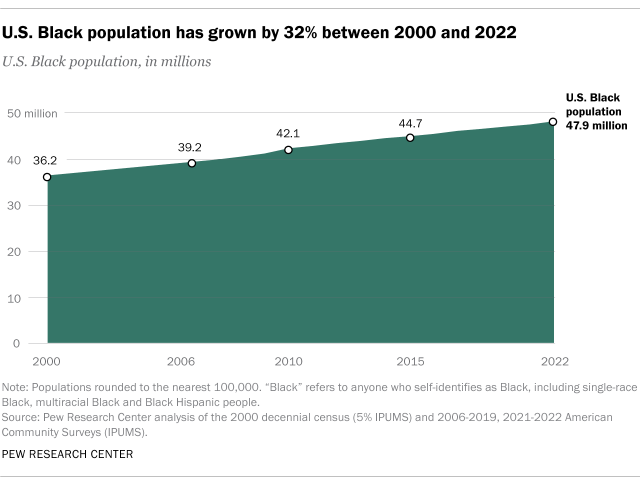
In 2022, the single-race, non-Hispanic Black population was the largest demographic subgroup of U.S. Black population, numbering 39.6 million or 83% of the total. This marks an increase of 17% since 2000, when the population was 33.7 million.
About 4.1 million members of this population are immigrants for other countries, meaning 10% of single-race Black people are foreign born in 2022. This is an increase over 2000, when 1.9 million people (roughly 6%) among the single-race, non-Hispanic Black population were foreign born.
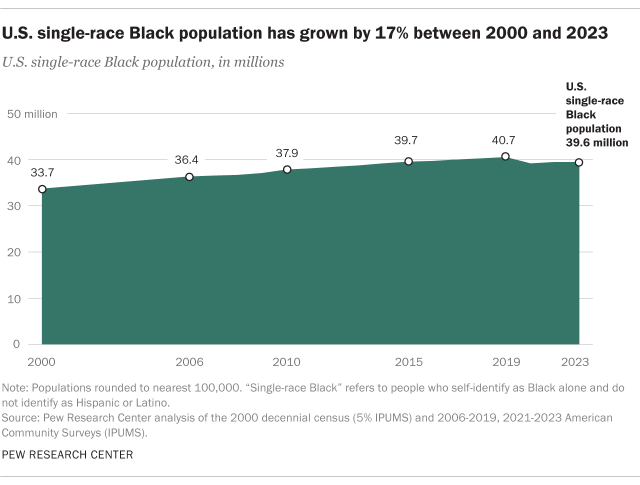
It’s important to mention that the share of those in the United States – not just Black Americans – who identify with more than one race has grown in recent years. Part of this is due to expansions in how the U.S. Census Bureau asks about ethnic and racial identity. Starting in 2000, the Census Bureau has provided respondents with the option to identify as more than one race. Besides that, younger people are more likely to identify with multiple racial or ethnic identities, on forms or otherwise.
In addition, some people with multiple racial identities in their family history do not describe their racial identity as two or more races. This suggests there is likely a discrepancy between the number of multiracial Black people in the U.S., as reported through demographic data analysis, and the number of multiracial Black people who identify themselves in this way.
The multiracial non-Hispanic Black population is the second-largest subgroup among Black Americans, with 5.4 million people – accounting for 11% of the overall Black population in 2022. It has grown from 1.5 million in 2000, a 254% increase.
Additionally, 430,000 members of the multiracial Black population (8%) are foreign born as of 2022. The number of foreign-born members of this group has increased from 250,000 people in 2000, but their share of the multiracial Black population has decreased from 16% in 2000.
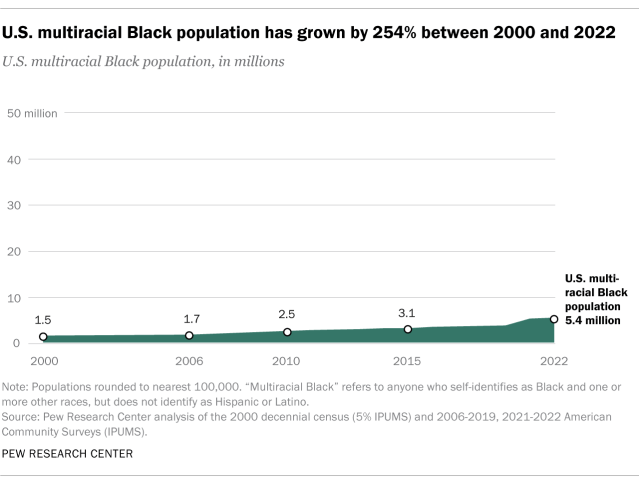
There were 2.9 million Black Hispanic people in the U.S. in 2022, which was 6% of the total Black population that year, making this subgroup the smallest population group included in this analysis. This population has grown from 980,000 in 2000 to 2.9 million in 2022, an increase of 199%.
Additionally, 500,000 members of this population are immigrants to the U.S., meaning that almost one-in-five Black Hispanics (18%) are foreign born. The number of foreign-born members of this group has increased from 260,000 people in 2000, but their share of the Black Hispanic population has decreased from 27% in 2000.
Notably, the Black Hispanic U.S. population is not necessarily the same population as the nation’s Afro-Latino population, as not all people who say they are Black and Hispanic identify as Afro-Latino and not all Afro-Latinos self-identify as Black, Hispanic or with both identities.
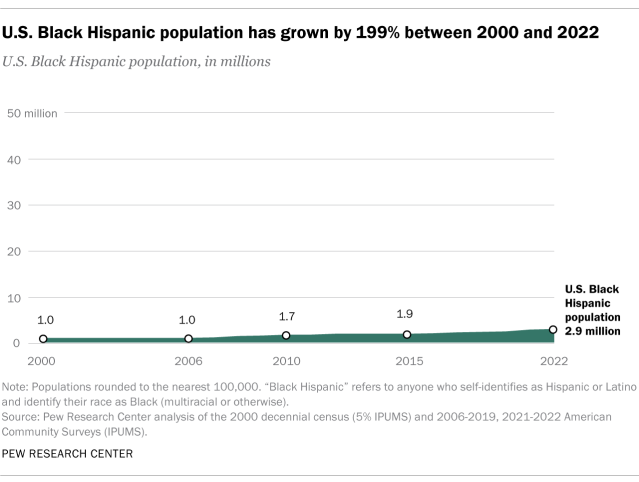
Age structure
The U.S. Black population is young. The median age of Black people in 2022 was 32.1 years, nearly six years younger than the U.S. population’s median age of 38.0. Roughly 30% of the entire Black population was below the age of 20 while 12% were 65 or older.
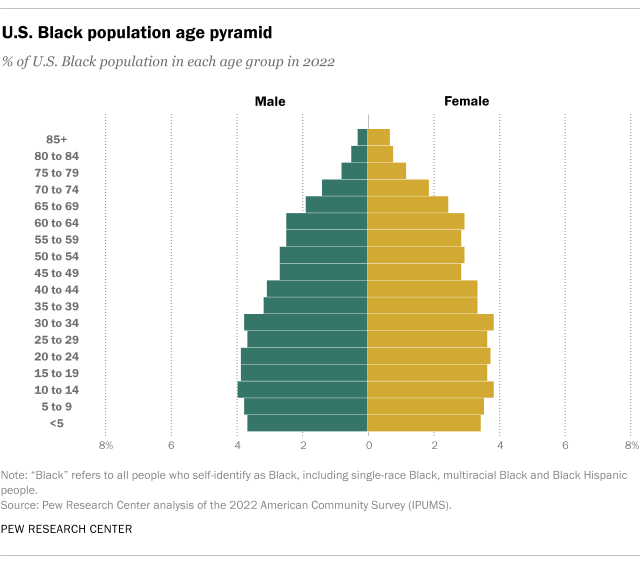
Just under half of the U.S. Black population (45%) was younger than 30 in 2022. A similar share (43%) was between 30 and 64 years old.

Fertility in the past year
The general fertility rate among Black females ages 15 to 44 was 6.1% in 2022, meaning that 6.1% of females in this age group had a birth in the previous 12 months.
The single-race, non-Hispanic Black population is also young. The median age of single-race Black people in 2022 was 34.9, three years younger than the full U.S. population’s median age of 38.0. Roughly 26% of the single-race Black population were below the age of 20, and 13% were 65 or older.
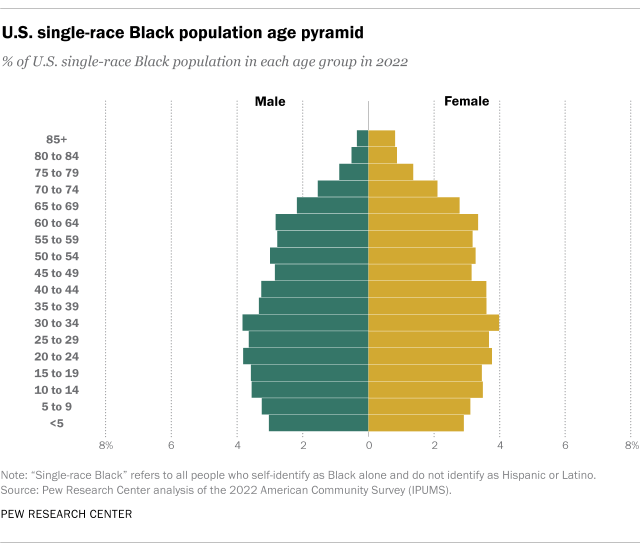
Roughly two-in-five members of the single-race Black population in the U.S. (41%) were under 30 in 2022. An additional 46% were ages 30 to 64.
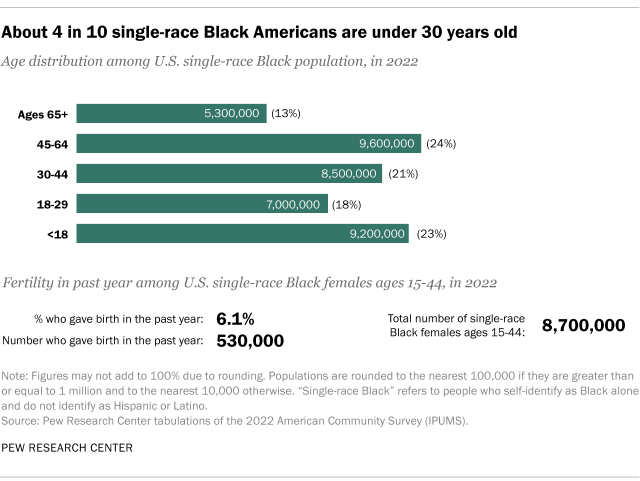
Fertility in the past year
The general fertility rate among single-race Black females ages 15 to 44 in the U.S. was 6.1% in 2022, meaning that 6.1% of females in this age group had a birth in the previous 12 months.
The multiracial, non-Hispanic Black population pyramid shows that this population is particularly young. The median age of multiracial Black people in 2022 was 19.5, making this the youngest subgroup of the Black population and significantly younger than the U.S. population overall (which had a median age of 38.0). About half (49%) of the multiracial Black population was below the age of 20 in 2022, and only 5% were age 65 or older.
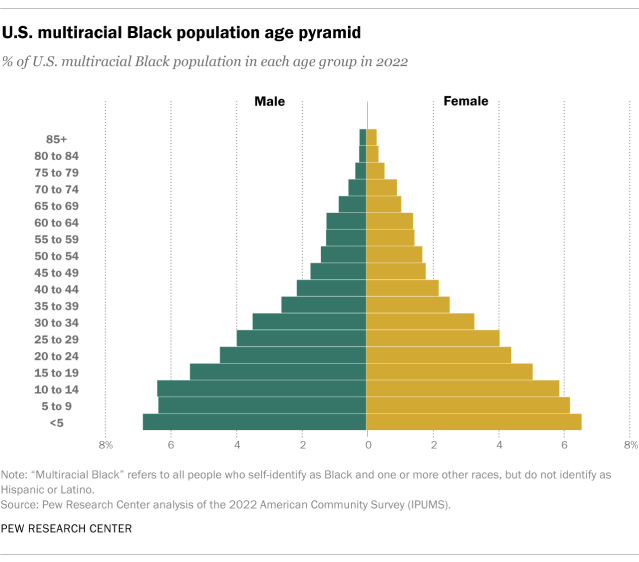
In 2022, two-thirds (66%) of multiracial Black people in the U.S. were under 30, while about three-in-ten (28%) were ages 30 to 64.
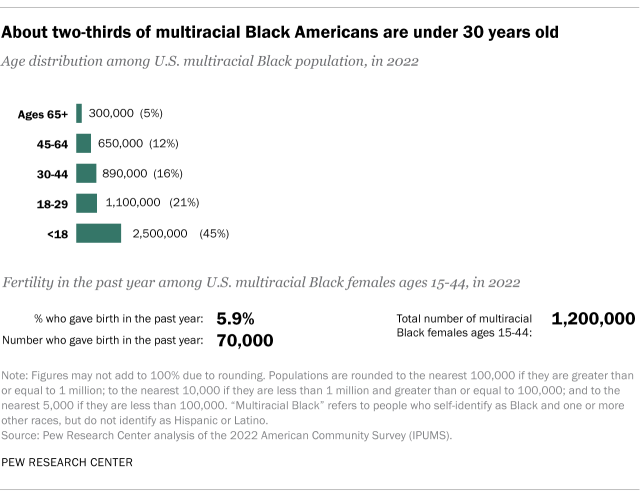
Fertility in the past year
The general fertility rate among multiracial Black females ages 15 to 44 in the U.S. was 5.9% in 2022, meaning that 5.9% of females in this age group had a birth in the previous 12 months.
The total Black Hispanic population is also quite young. The median age of this population group in 2022 was 21.0 years, making Black Hispanics the second-youngest group included in this analysis, and notably younger than the U.S. population, which had a median age of 38.0 years.
Just under half (46%) of the Black Hispanic population was below the age of 20, and 5% were 65 or older.

In 2022, 62% of the Black Hispanic population in the U.S. were under the age of 30. An additional 33% were ages 30 to 64.
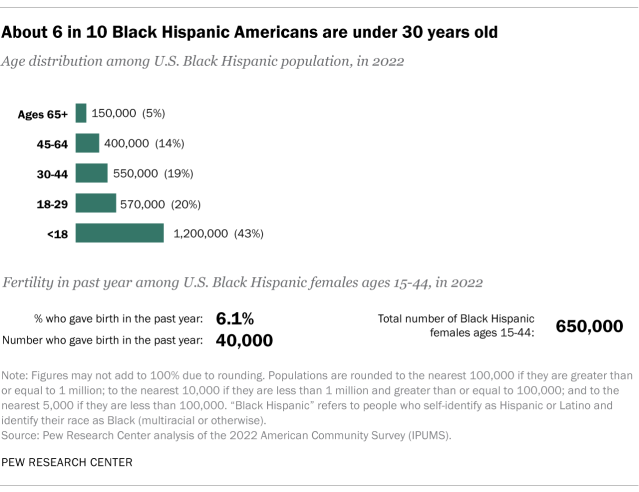
Fertility in the past year
The general fertility rate among Black Hispanic females ages 15 to 44 in the U.S. was 6.1% in 2022, meaning that 6.1% of females in this age group had a birth in the previous 12 months.
Languages
The vast majority (96%) of the Black population as of 2022 either speaks only English (89%), or they speak another language at home and also say they speak English very well (8%). Besides English, other languages spoken at home by the U.S. Black population ages 5 and older include Spanish (4%), French or Haitian Creole1 (3%) and Amharic and other Ethiopian languages (1%).
The vast majority (97%) of the single-race Black population in 2022 either speaks only English (91%) or, if they speak another language at home, say they also speak English very well (7%). Besides English, other languages spoken by this part of the population ages 5 and older include French or Haitian Creole2 (3%), Spanish (1%) and Amharic and other Ethiopian languages (1%).
The vast majority (98%) of the multiracial Black population in 2022 either speaks only English (92%) or, if they speak another language at home, say also they speak English very well (6%). French or Haitian Creole3 is spoken by 1% of the multiracial Black population that is over age 5, as are Spanish, Portuguese and Afrikaans.
A substantial majority (83%) of the Hispanic Black population in 2022 speaks either only English (53%) or, if they speak another language at home, say they also speak English very well (30%). Besides English, just under half (46%) of this population ages 5 and older speaks Spanish, and 1% speaks French or Haitian Creole.4
Geography
Regionally, the highest concentration of Black people in the U.S. in 2022 is in the South; more than half (56%) live there. Another 17% each live in the Midwest and Northeast, and 10% live in the West.
When it comes to states of residence, Texas is home to the largest Black population, at about 4.2 million. Florida comes in a close second with 3.9 million, and Georgia comes in third, with 3.7 million.

Among metropolitan areas, the New York City metro area – which includes parts of New Jersey and Pennsylvania – has the greatest number of Black residents (3.6 million). In a distant second is the Atlanta metro area, with 2.2 million, and the Chicago metro area is third with 1.7 million Black residents.
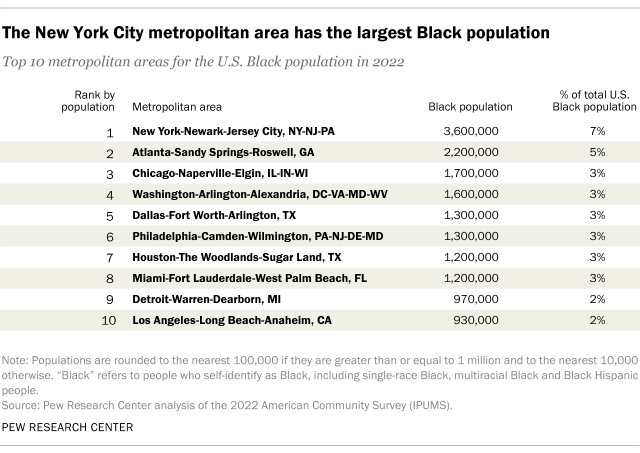
The South is also the region with the highest concentration of the single-race U.S. Black population: 59% of that group lives there as of 2022. The Midwest is home to 17%, while another 15% live in the Northeast and 9% live in the West.
The state of Texas has the largest number of single-race Black people (around 3.5 million), followed by Georgia (roughly 3.4 million) and Florida (about 3.2 million).
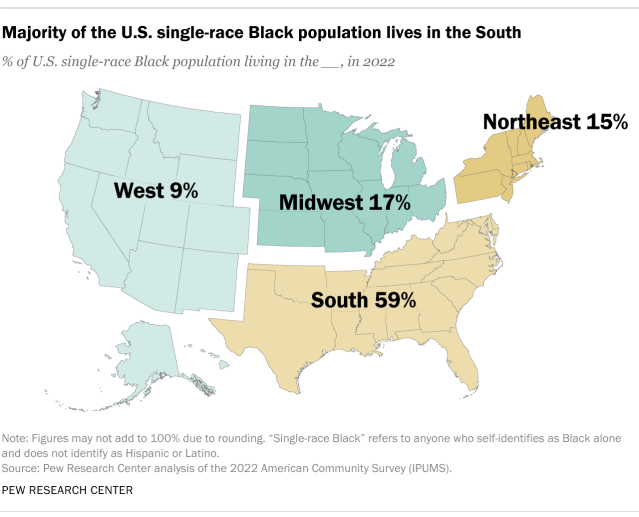
Among metropolitan areas, the New York City metro area (including parts of New Jersey and Pennsylvania) has the nation’s largest single-race Black population, with roughly 2.8 million. Other top metropolitan areas include Atlanta; Chicago; Washington, D.C.; and Dallas.
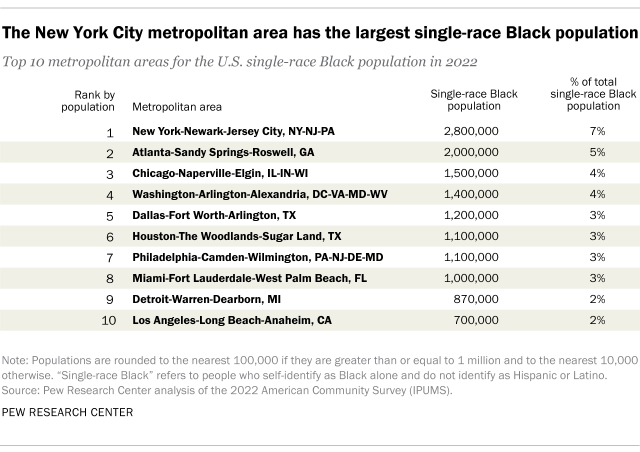
Regionally, the South is home to the highest concentration of the multiracial Black population in the U.S., with a plurality (41%) of the total as of 2022. Roughly one-fifth each live in the Midwest (22%), the West (19%) and the Northeast (18%).
California is the top state of residence for multiracial Black people, with about 490,000 living there. Texas is home to 390,000 multiracial Black people, while Florida has 370,000.
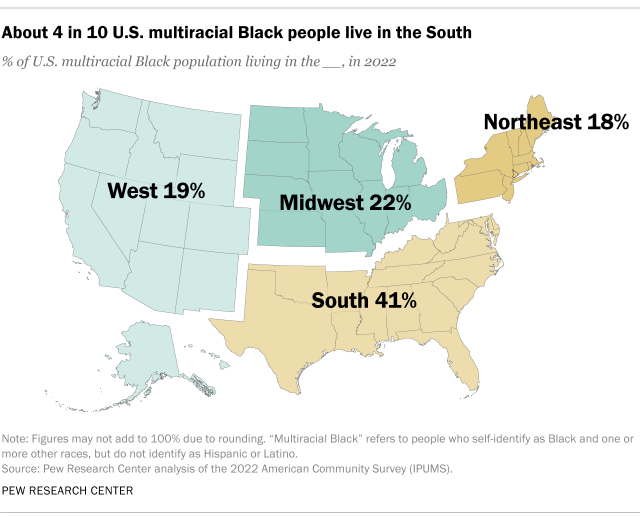
Among metropolitan areas, the New York City metro area – which includes parts of New Jersey and Pennsylvania – has the highest number of multiracial Black residents (300,000). Other top metropolitan areas for this subgroup include Los Angeles; Atlanta; Washington, D.C.; and Chicago.
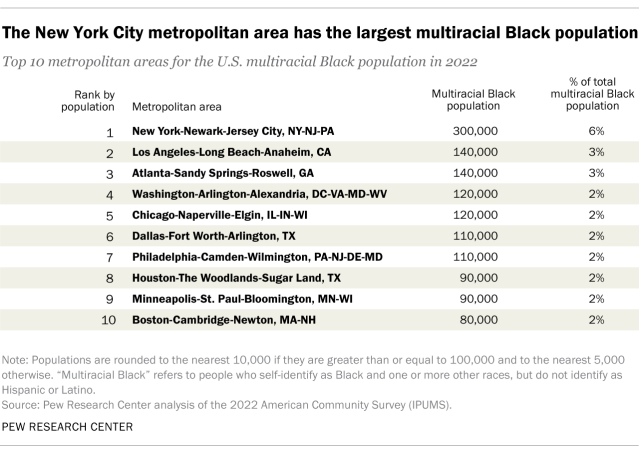
Regionally, Black Hispanic people are largely concentrated in the Northeast and South (71% in total). About one-in-five live in the West (19%) and 0ne-in-ten live in the Midwest as of 2022. New York is the top state of residence for the Black Hispanic population, with 490,000 people living there. Florida is home to the second-highest number of this population (330,000), and California comes in third with 320,000 people.
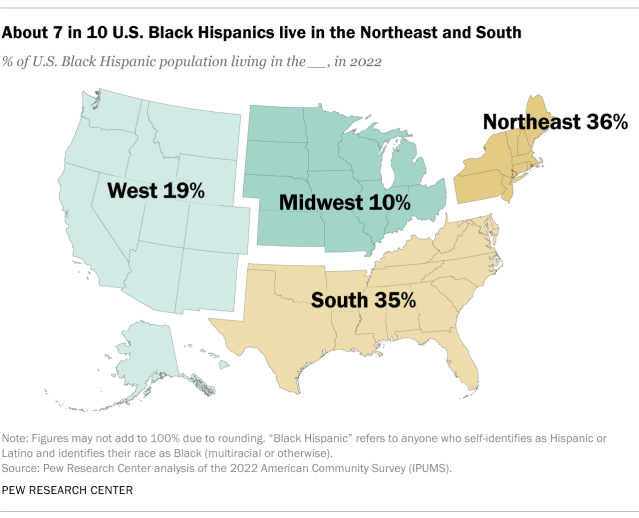
Among metropolitan areas, the New York City metro area – which includes parts of New Jersey and Pennsylvania – has the largest Black Hispanic population (520,000 people). Other top metropolitan areas for this subgroup include Miami, Los Angeles and Philadelphia.
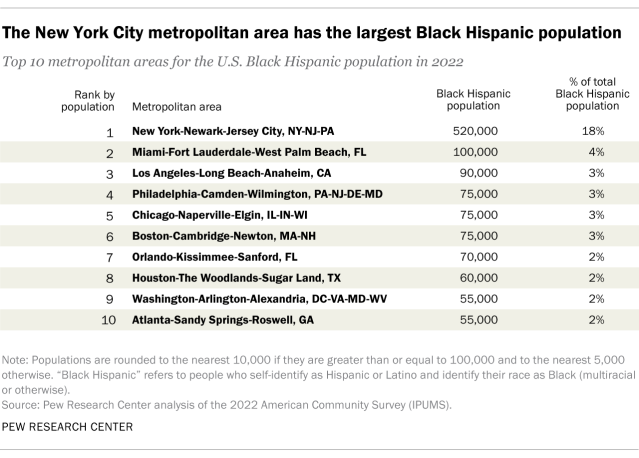
Household income
Among Black U.S. households in 2022, 49% earned less than $50,000, while 51% made $50,000 or more. A third of Black households (34%) earned $75,000 or more, including 22% that made $100,000 or more.
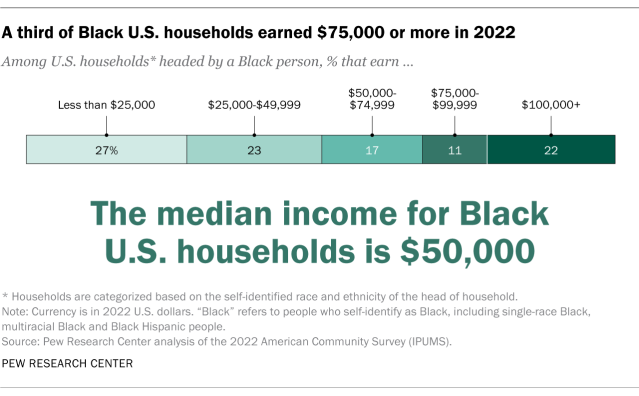
Half of single-race, non-Hispanic Black U.S. households in 2022 earned less than $50,000, while the other 50% made $50,000 or more. A third (33%) earned $75,000 or more, including about a fifth (22%) that made $100,000 or more.
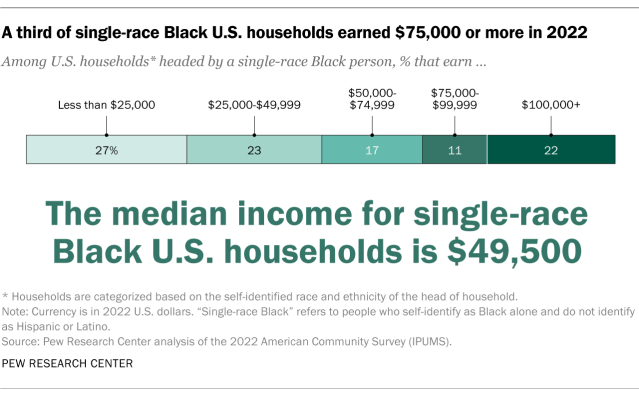
The median household income for multiracial, non-Hispanic Black U.S. households is $60,000, meaning half of households headed by a multiracial Black person earned more than that and half earned less than that sum as of 2022.
Looking at income another way, 42% of households with a multiracial Black householder made less than $50,000, and 58% earned that amount or more. About four-in-ten (41%) made $75,000 or more, including 28% that made $100,000 or more.
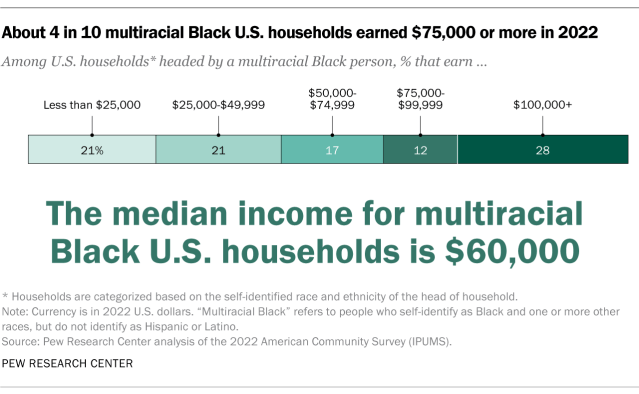
The median household income for Black Hispanic U.S. households is $56,500, meaning half of households with a Black Hispanic household head earned more than that and half earned less in 2022.
Further analysis shows about half (44%) of Black Hispanic households earned less than $50,000, while 56% made over $50,000. Roughly four-in-ten of these households (38%) earned $75,000 or more, including a quarter that made $100,000 or more.
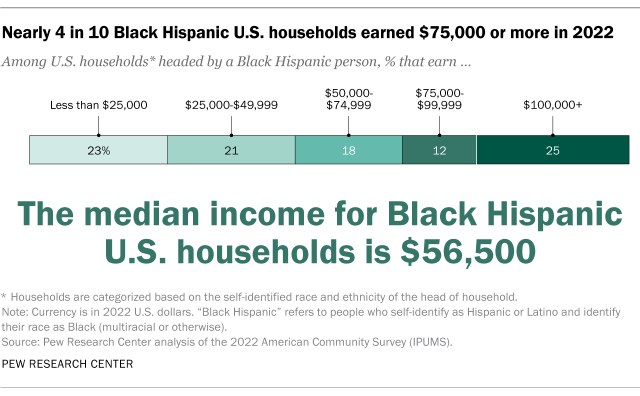
Household type
About four-in-ten Black people in the U.S. (39%) live in households that are headed by married couples as of 2022. Roughly three-in-ten Black people (31%) live in households whose household head is female, and 5% live in male-headed households. Fewer than two-in-ten (16%) are part of non-family households.
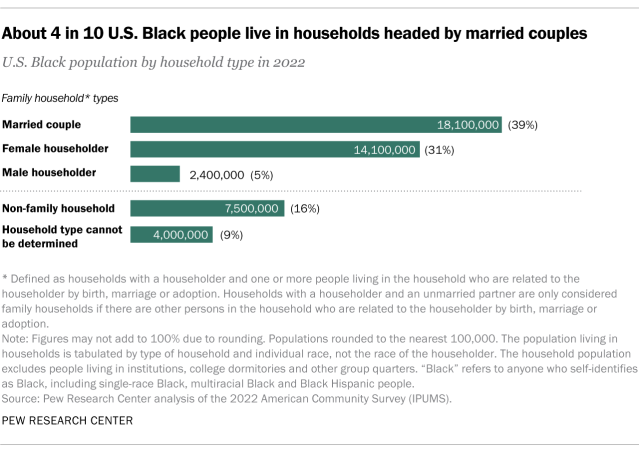
More than a third (38%) of single-race Black people in the U.S. live in households that are headed by married couples as of 2022. Roughly three-in-ten single-race Black people (31%) live in households with female household heads, and 5% live in male-headed households. Fewer than two-in-ten (17%) live in non-family households.
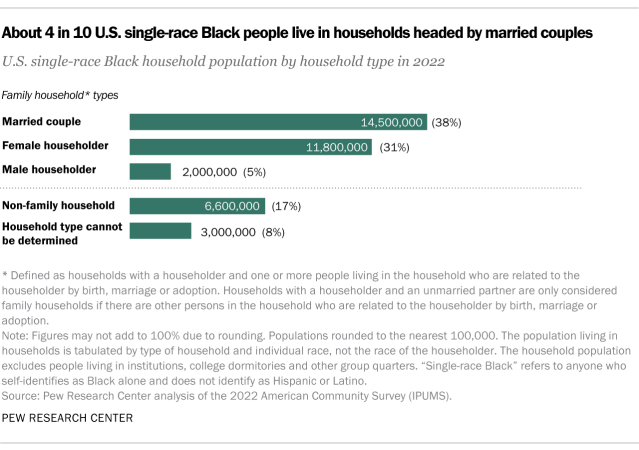
Just under half of multiracial Black people in the U.S. (44%) live in households that are headed by married couples as of 2022. About three-in-ten (28%) live in households whose head is female, and 5% live in male-headed households. Additionally, roughly one-in-ten multiracial Black people (11%) live in non-family households.
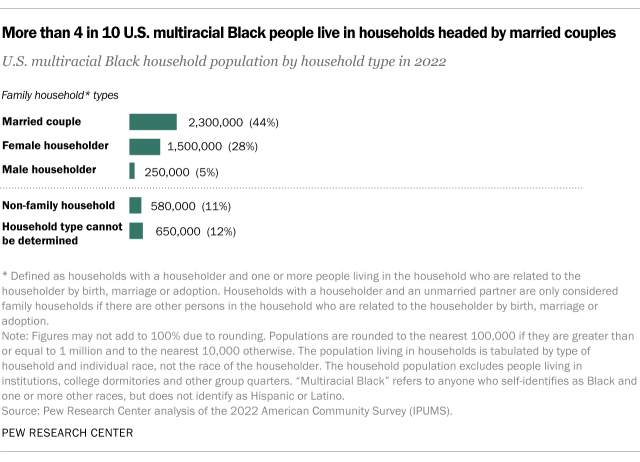
Roughly four-in-ten Black Hispanic people in the U.S. (44%) live in households headed by married couples in 2022. About three-in-ten Black Hispanic people (29%) live in female-headed households, and 5% live in households headed by male householders. One-in-ten Black Hispanic people live in non-family households.
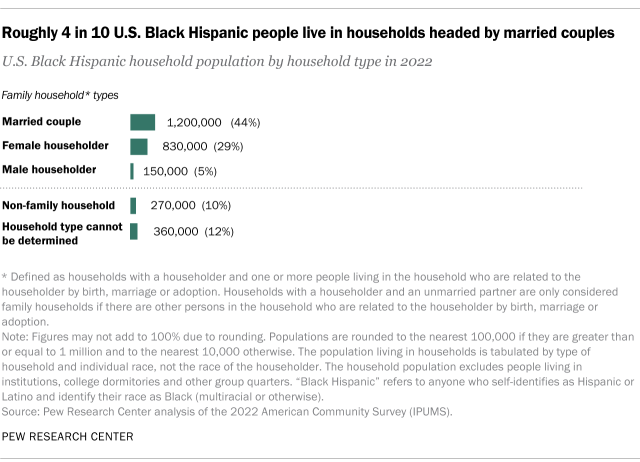
Educational attainment
About a quarter (26%) of all Black U.S. adults ages 25 and older have a bachelor’s degree or more education. As of 2022, another third (32%) have completed some college without obtaining a bachelor’s, and roughly four-in-ten (42%) have, at most, graduated from high school (or earned an equivalent such as a GED certificate).
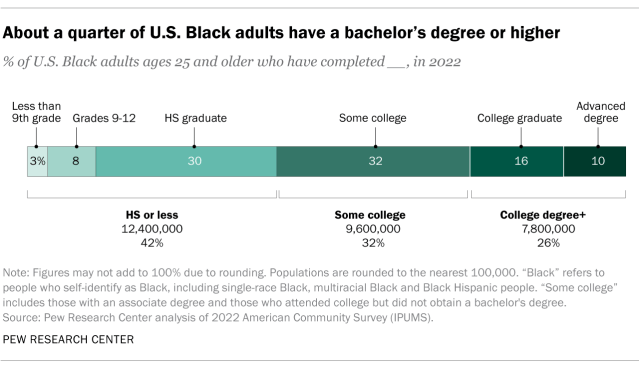
A quarter of single-race Black U.S. adults ages 25 and older have earned a bachelor’s degree or higher as of 2022. Another third (32%) have completed some college without obtaining a bachelor’s and 43% have, at most, graduated from high school or obtained an equivalent certificate.
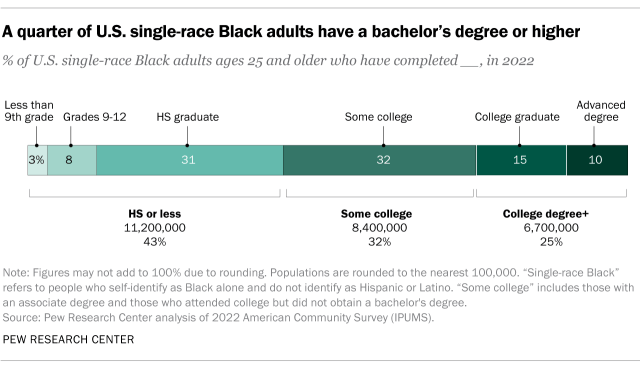
A third (33%) of multiracial Black U.S. adults ages 25 and older have earned a bachelor’s degree or higher as of 2022. Similar shares have completed some college without obtaining a bachelor’s (35%) or, at most, graduated from high school or its equivalent (32%).
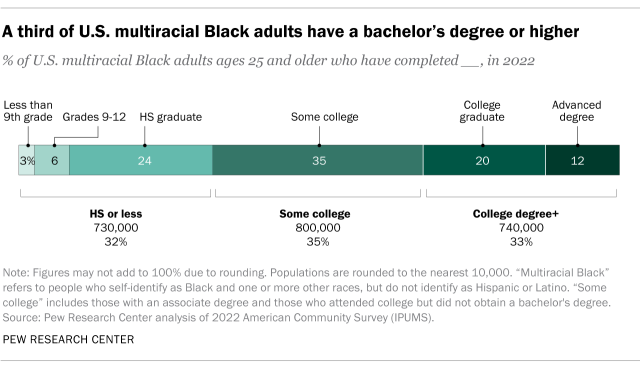
Almost three-in-ten Black Hispanic U.S. adults ages 25 and older (29%) have earned a bachelor’s degree or higher as of 2022. A similar share (31%) have completed some college without obtaining a bachelor’s, while 41% have, at most, graduated from high school or its equivalent.
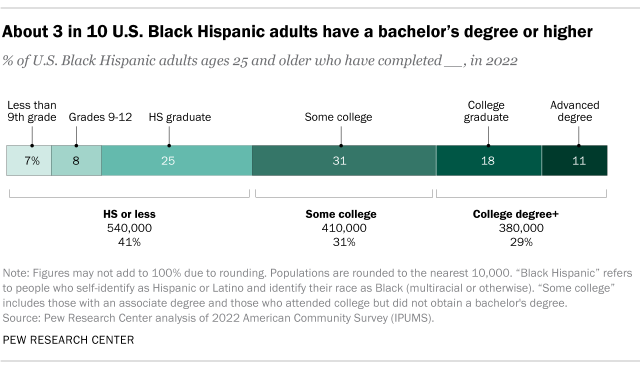
Religious affiliation
Two-thirds (66%) of all Black adults identify as Protestant. Roughly one-in-five (21%) are religiously unaffiliated, while smaller shares of adults identify as Catholic (6%), or with other Christian denominations (3%) or non-Christian faiths (3%).
For more, read “Faith Among Black Americans”

A majority (69%) of single-race Black adults identify as Protestant. Roughly one-in-five (19%) are religiously unaffiliated, while smaller shares of adults identify as Catholic (5%), or with other Christian denominations (3%) or non-Christian faiths (3%).
For more, read “Faith Among Black Americans”
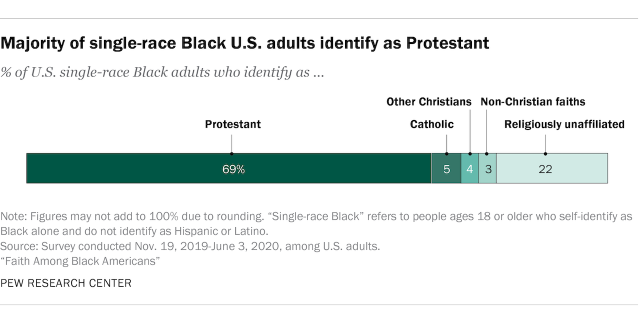
Similar shares of multiracial Black adults identify as Protestant (41%) or as religiously unaffiliated (38%). Smaller shares of adults within this population subgroup identify as Catholic (11%), or with other Christian denominations (4%) or non-Christian faiths (6%).
For more, read “Faith Among Black Americans”
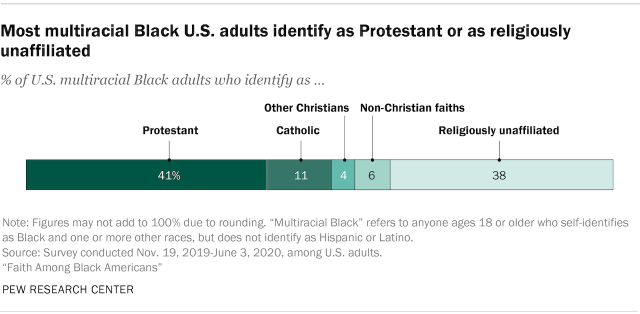
Almost six-in-ten Black Hispanic adults (59%) identify as either Protestant (35%) or Catholic (24%). A third identify as religiously unaffiliated (33%), while smaller shares identify with other Christian denominations (2%) or follow non-Christian faiths (6%).
For more, read “Faith Among Black Americans”
